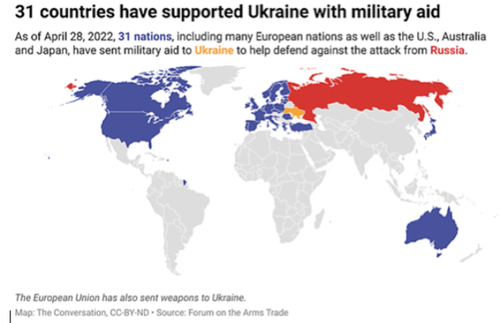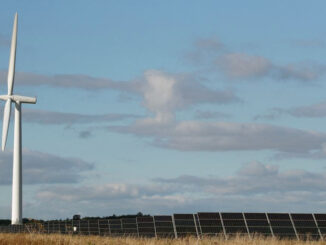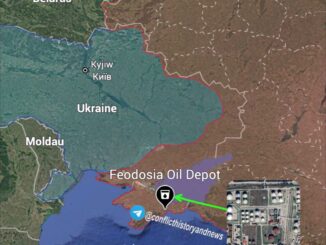
Authored by Satyajit Das via NakedCapitalism.com,
Ordinary lives are lived out amidst global economic, social and political forces that they have no control over. Today, multiple far-reaching pressures are reshaping that setting.
This three-part piece examines the re-arrangement. This part examines current great geopolitical divisions. The second and third part, will look at key vulnerabilities and possible trajectories respectively.
There are decades where nothing happens; and there are weeks where decades happen“. The pithy phrase (the attribution to Lenin is contested) encapsulates periods when established orders are challenged and sometimes overturned, often violently. The question is whether this is one of those times.
Today, there is a sharp division between the ‘West’ – the US and its Anglosphere acolytes (Canada, Australia, New Zealand) supported unenthusiastically by Europe and Japan- and the rest of the world. While a simplification, the categorisation is helpful in understanding key contemporary events and potential changes to the current global order.
Points of Difference
Positions on the Ukraine conflict highlight the schism. Support for Ukraine is primarily Western, representing around half of global GDP but less than 20 percent of world population.
Couched in platitudes about shared values and unity, Europe and Japan’s tepid support of the Anglosphere reflects competing priorities. Like the Anglosphere, they benefit from American military protection which lowers defence spending allowing resources to be used more productively. Despite a 2006 commitment to defence spending of 2 percent of GDP, NATO members average only 1.6 percent, with Germany, Italy, the Netherlands and Spain spending 1.3-1.5 percent. At the same time, geographic proximity to Russia and China as well as greater economic connections complicate allegiances.
Relationships between Germany, Japan and the West bear deep scars. The former has fought two world wars against its Western allies. The US and Britain reduced much of these countries to rubble. America deployed nuclear weapons against Japan with the ancillary objective of intimidating potential rivals. The rehabilitation of Germany and Japan served US post-World War 2 interests, creating bulwarks against the threat of communism. It reversed the original plan of reducing both to agrarian pasts unable to compete with America globally.
While urging a rapid end to hostilities, the majority of nations have been reluctant to condemn Russia’s actions, often professing neutrality. With an eye to its own regional territorial claims, China acknowledges Russian grievances. China and India along with most nations are sensitive about foreign intervention in their internal affairs. The West has highlighted recent public expressions of disquiet by Chinese and Indian leaders. However, there was no direct reference to or support of Ukraine. The comments mainly focused on the conflict’s impact on food, fuel and fertiliser supplies. Most nations prefer the benefits of maintaining relationships with all.
The conflict has unified the West against Russia and given NATO renewed focus. But Ukraine has also created a common cause for those with long standing grievances against the West. Countries such as Iran, a US branded member of the “axis of evil“, have sought to exploit the widening gulf between global factions. They have become suppliers of military equipment to Russia. This opportunistic co-operation exacerbates the global split.
The non-Western position reflects history. Associations are complicated by racially charged, exploitative colonial pasts, and experience of Western hypocrisy. There are legitimate questions about the support for Ukraine, especially the provision of generous financial and humanitarian aid, compared to that offered to forgotten victims of conflicts and disasters in the Middle East, Asia and Africa. The favoured treatment of white, Christian refugees has not gone unnoticed.
A Sea of Troubles
The avoidable Ukraine conflict, with its unnecessary destruction and human suffering, is best seen as a catalyst.
Unwillingness to recognise core interests of parties, increasingly entrenched positions, and lack of interest in negotiations means a spiral into a wider confrontation is not impossible. With escalation difficult to calibrate, the evolution from a proxy into a real war between the US and Russia, which might draw in China, all nuclear-armed, remains possible.
The West’s expressed desire for engineering regime change within Russia is dangerous. Any new regime may not be more amenable to Western pressure. History, most recently the Arab Spring and Colour Revolutions, shows that a dangerous political void is more likely than liberalisation.
Whatever the length, dimensions and outcome, Ukraine has exposed already present major differences in the world. In particular, the West’s response -trade restrictions, sanctions and asset seizures- will outlive the military actions and prove more damaging.
The weaponization of trade and finance, modern gunboat diplomacy, has a long lineage. Sanctions and blockades were used in World War 1 and influenced Japan’s entry into World War 2. Western embargoes against communist bloc countries were common during the Cold War. Since 1979, the US has sought to isolate the Islamic Republic of Iran established by a popular revolution which overthrew the Shah, who had been installed by an American coup d’?tat. Measures against Russia commenced in 2014. The US has imposed progressively more stringent restrictions on China covering exports and sales of critical technologies since 2018.
In the short term, the measures have affected Covid19 disrupted supply chains, aggravating shortages and price inflation, especially in food, energy and raw materials. In the longer-term, the interaction with other stresses may prove significant.
The effects of climate change driven extreme weather – droughts, floods, storms, wildfires- on food production and transportation links is accelerating. A triple dip La Ni?a alone threatens large scale disturbance with a potential global cost of $1 trillion (around 1 percent of global GDP). Resource scarcity – water, food, energy, raw materials- is simultaneously rising due to natural limits.
The decisions by major producers to increasingly stockpile or limit foreign sales to ensure domestic supply and control local costs are adding to disruptions to food production,. As of mid-2022, 34 countries had imposed restrictive export measures on food and fertilizers contributing to surging prices of key staples.
Energy shortages are not purely the result of sanctions on Russian oil and gas exports. Underinvestment, due to ESG compliant investors limiting funding for traditional energy sources, has affected supply. The necessary but over-hyped transition to renewables is a contributor. Proponents have overestimated its speed and underestimated the challenges of substituting existing generation capacity, reconfiguring electricity systems and converting industry and heavy transportation to non-fossil fuels. Shortages of critical metals and minerals, many non-recyclable, will retard conversion to new energy sources.
Given the world’s high energy needs, availability and cost will remain a major issue. Progress on controlling climate change, already inadequate, will reverse, perhaps fatally. Concern about emissions has been replaced by focus on energy security. A reversion to fossil fuels to lower prices and the cost of living is already apparent.
Slowing globalisation, which previously drove global growth, is another factor. Despite its benefits, greater economic integration has drawbacks. It reduces national sovereignty. Sharing of benefits and costs are frequently unequal. The 2011 Thai floods, the Tohoku earthquake, tsunami and resultant Fukashima nuclear plant disaster, and multiple episodes of extreme weather have illustrated the fragility of just-in-time production and tightly coupled global supply chains. The Ukraine conflict is the latest chapter in this history.
The 2008 Global Financial Crisis and Great Recession played its part. It exposed a key globalisation funding mechanic – large financial imbalances (China-US and intra-Europe). Germany and China needed the US, the world’s consumer of last resort, the Southern Eurozone and the Anglosphere to absorb their surplus production. The resulting large current account surpluses financed deficits in the consuming countries. 2008 underscored the risk of this strategy for savers – primarily Chinese, East Asian, German, Japanese and oil exporters. China’s Premier Wen Jiabao spoke for all when expressing concern about the safety and security of their capital.
The Western response to the financial crisis added to the disquiet and fed global division. The beggar-thy-neighbour monetary, fiscal and currency policies of advanced economies were destabilising for many countries.
China, Russia and India, to different degrees, saw the events of 2008 as signalling Western weakness and validation of their state controlled political and economic systems. It encouraged a distrust of the West and strengthened the belief that evolution into more open economies and societies was risky. Resistance to greater globalisation was the result.
While these pressures are likely to persist, complete deglobalisation and a retreat to autarky is unlikely in the short run. It is simply too difficult to replace intricate connections created over several decades overnight. More importantly, the effect on availability and cost of products would be great, reducing living standards. Instead, a dollop of decoupling is the most likely course. Increased re-, near- or friend-shoring of goods and services production is possible. Digital or e-globalisation may continue. But the retreat into distinct groupings or trading blocs – a us-and-them world- will be difficult to arrest.
Changes in the electoral dynamic are reinforcing the shift. Financial crises, economic stagnation, inflation, shortages, war and pestilence (the Covid19 pandemic) generate anxiety and fear. Politicians in all countries have exploited the instability.
Without tractable solutions, mainstream parties have largely lost their dominance. The appeal of strong, populist leaders has increased. Increasingly, the strategy is to put a reasonable face and emollient gloss over often unpalatable views in order to get elected.
Like traditional parties, the populists, both of the left and right, do not have answers to the major problems of the day. Instead they parade nationalist credentials and strong leadership. They target globalisation, elites (Davos Man), foreigners, immigration and overseas interference in domestic matters.
For democracies, the crisis is deepening. For existing authoritarian nations, it has strengthened latent instincts for centralised control, one party systems and repression.
The combination of these stresses have set up feedback loops which are now reshaping existing economic and power relationships.
Winners and Losers
All nations are affected by these changes, but not equally.
Functioning as an isolated entity or bloc requires a sizeable population, large internal market, self-sufficiency in key resources (food; water; energy; raw materials), necessary technologies and skills, and ability to ensure your security. The alternative is assured access to these elements from within your trading bloc or allies.
The sanctions imposed following the Ukraine conflict illustrate the dynamics. The limited effect, to date, of restrictions reflects the fact that Russia possesses many of the identified characteristics to operate as a near autarky. The absence of universal compliance also reduces the effectiveness of measures like sanctions.
Non-West countries, such as China and India, have an incentive to defy sanctions. They benefit financially from the ability to purchase oil and gas at significant discounts, sometime re-selling it raw or as refined products. Attempts at more complete enforcement, such as oil and gas price caps, may not be successful. It would require exclusion of all violators from global payments and insurance or imposition of secondary sanctions. But preventing access to insurance for shippers carrying Russian oil will disadvantage poorer countries but not large nations, like China and India, able to self-insure.
Jenga games of balancing cutting off Russian energy sales and ensuring adequate supplies to control prices was always going to be beyond the capabilities of economically-challenged bureaucrats and politicians.
China illustrates a different approach. It lacks self-sufficiency in food and raw materials, such as iron ore and energy. Strategic overseas investments, the Brick and Roads Initiative and leasing farmland target these deficiencies. Interestingly, Russia can supply a significant part of the Middle Kingdom’s food, energy and mineral needs although this would require reconfiguration of infrastructure. This process is already observable in global energy markets with Russian output being redirected East while Gulf and Australian supplies going to the West.
Having been relatively isolated until the 1990s, countries like Russia, China and India are not fully integrated into the global market system. Legacy structures are capable of reverting to a more closed economy.
In recent years, these countries have increasingly redirected policies and investment towards their home markets, abandoning reflexive globalism. The objective is the greatest possible independence and control over strategic sectors and essential products. For example, China has developed and sought to force businesses and population to adopt its Beidou satellite navigation system instead of the US GPS satellite system and Europe’s Galileo. In parallel, it seeks to export technology to build networks of client economies and governments frequently incorporating them into aid packages, soft loans and commercial transactions.
The West is more reliant on global commerce, although individual positions differ.
The US is substantially self-sufficient in food and energy. However, it has outsourced large components of its manufacturing and would have to re-skill its workforce to re-shore activities. It also requires export markets for its products – around 40 percent of S&P 500 companies’ revenue originates outside the US.
Canada, the UK, Australia and New Zealand enjoy varying degrees of food and resource self-sufficiency. Canada, Australia and New Zealand are exporters of food or raw materials. The UK is a significant exporter of services. All depend on imports of manufactured goods, a significant proportion of which is from China.
Europe and Japan are oriented to manufacturing exports, with significant reliance like the Anglosphere on Chinese demand. Both are reliant on imported raw materials, especially energy. Japan has a growing reliance on imported foodstuffs, with its food self-sufficiency rate having fallen to around 38 percent of calories consumed from 73 percent in 1965 because of rising demand for foodstuffs it cannot supply, like meat.
The West’s major disadvantage is its high cost structures, which have been offset in recent decades by imported cheap labour and raw materials. Europe, especially Germany, has tied its economic fortunes to the availability of low-cost Russian gas. If forward prices prove correct, then Europe’s gas and electricity cost would reach nearly EUR2 trillion ($2 trillion or around 15 percent of GDP). The high operating leverage in the case of Germany equates to around $2 trillion of value added production from $20 billion of imported Russian gas.
Attitudinal differences are important. Asiatic patience and memory breed resilience. A fatalistic acceptance of life’s constraints and caution about progress makes the non-West more resistant to setbacks and reversals.
In his 1933 work In Praise of Shadows, Japanese writer Junichiro Tanazaki captured this divergence: “We… tend to seek our satisfactions in whatever surroundings we happen to find ourselves, to content ourselves with things as they are; and so darkness causes us no discontent, we resign ourselves to it as inevitable. If light is scarce then light is scarce; we will immerse ourselves in the darkness and there discover its own particular beauty. But the progressive Westerner is determined always to better his lot. From candle to oil lamp, oil lamp to gaslight, gaslight to electric light – his quest for a brighter light never ceases, he spares no pains to eradicate even the minutest shadow.”
Changes in the existing global economic structure threaten Western living standards. The disruption of global trade and mobility during the Covid19 Pandemic and resulting shortages provided a window into these susceptibilities.
Mutual Misunderstandings
The fracture reflects fundamental differences in belief and values. Western thinkers, as varied as Montesquieu, Adam Smith, Voltaire, Spinoza and John Stuart Mill, were wedded to the idea that trading between nations could overcome tribalism, national identity and ideology reducing the risk of conflict. There was also an implicit confidence about the dominance of the West.
Late twentieth century globalisation, with its espousal of free trade and capital movement, was indivisible from this political end and propagation of certain values. Integrating previous antagonists like China, Russia, India and others into global trading arrangements would bring about political change helping strengthen the West’s position. The end of history would produce the suzerainty of a carefully crafted internationalist economic system which favoured the West. Under chancellors from Willy Brandt to Angela Merkel, Germany exemplified this policy of “change through trade” which created the now troublesome energy dependence on Russia.
But Chinese, Russian and Indian engagement with this Western agenda was always superficial. China was effectively bankrupt when Deng Xiaoping assumed power in the late 1970s. India and Russia faced penury in the early 1990s. Embrace of globalisation was driven by necessity not conversion to Western values or economic tenets.
Liberalisation, allowing greater private ownership and a modicum of free enterprise, was designed to boost living standards to placate a restive population. There was never any great desire for fully opening up and wholesale reform of the economic or political system. At best, it was marginal changes to the basic planned economy model. The central idea of an insulated system capable of existing in isolation from the West was never abandoned.
President Xi has repeatedly emphasised the Chinese Communist Party’s traditional leadership in government, military, economic, civilian and academic matters. He has preached self-reliance and rejected competitive democracy, the rule of law and the separation of powers as foreign ideas. Far from being reformers, President Xi, President Putin and Prime Minister Modi see themselves as restorers of their country’s proper place in the world.
As their economies grew stronger, the necessity for real change became even less paramount. The political threat, especially for China and Russia, was exemplified by Western orchestration of and support for regime change, such as the Arab spring and colour revolutions. It encouraged disengagement and reversion to centralised control.
In 1910, in The Great Illusion, Normal Angell famously argued that war was impossible because of economic interconnections. World War 1 undid those illusions. Today, the Ukraine conflict and related stressors are, in a similar way, challenging established geo-political and economic arrangements.
* * *
Satyajit Das is a former banker and author of numerous works on derivatives and several general titles: Traders, Guns & Money: Knowns and Unknowns in the Dazzling World of Derivatives (2006 and 2010), Extreme Money: The Masters of the Universe and the Cult of Risk (2011), A Banquet of Consequences RELOADED (2021) and Fortune’s Fool: Australia’s Choices (2022).





